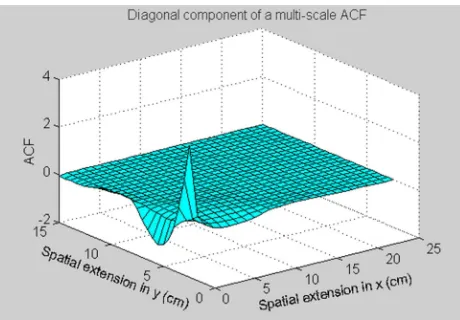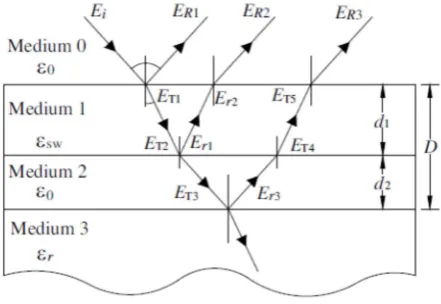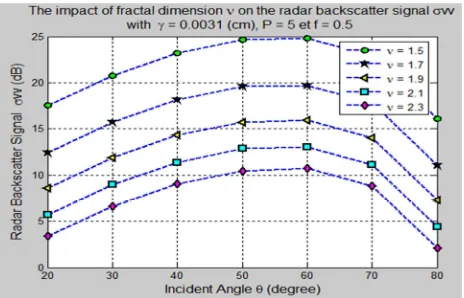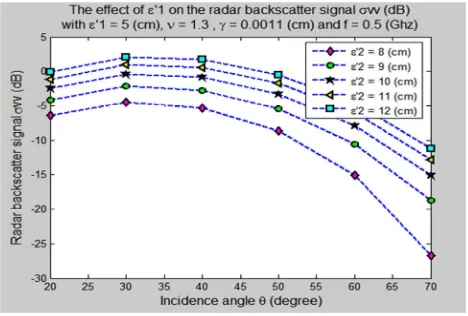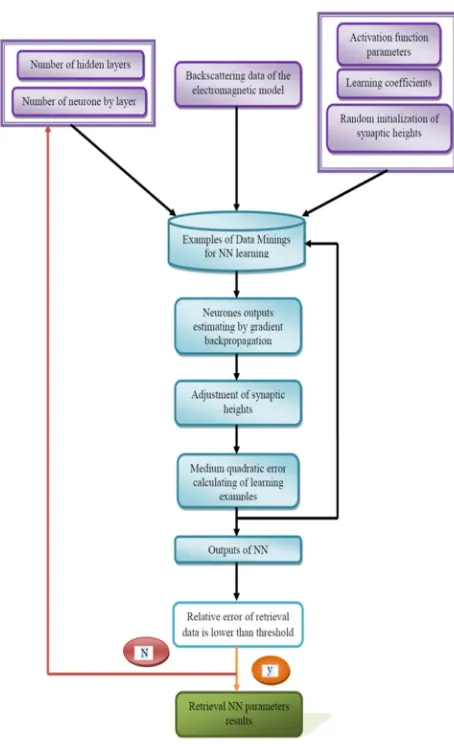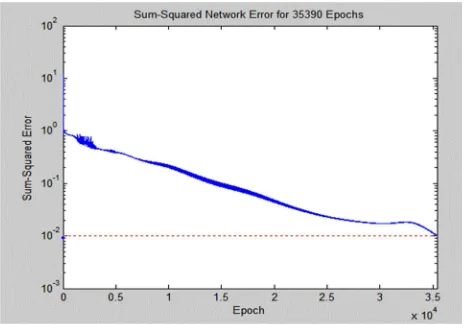INVERSION OF THREE LAYERS MULTI-SCALE SPM MODEL BASED ON NEURAL
NETWORK TECHNIQUE FOR THE RETRIEVAL OF SOIL MULTI-SCALE
ROUGHNESS AND MOISTURE PARAMETERS
I. Hosni *a,M. JaafriGhamki, *ab, L. Bennaceur Farah *a and M. S. Naceur*a a
LTSIRS, ENIT, Université El Manar, Tunis, Tunisia – [email protected]; [email protected]
b
RIADI, ENSI, Université de la Manouba, Tunis, Tunisia - [email protected]
KEY WORDS: Backscattering, multi-scale, multilayer, inversion, neural network
ABSTRACT:
In this paper, a multi-layered multi-scale backscattering model for a lossy medium and a neural network inversion procedure has been presented.
We have used a bi-dimensional multi-scale (2D MLS) roughness description where the surface is considered as a superposition of a finite number of one-dimensional Gaussian processes each one having a spatial scale using the wavelet transform and the Mallat algorithm to describe natural surface roughness.
An adapted three layers 2D MLS small perturbations (SPM) model has been used to describe radar backscattering response of semi-arid sub-surfaces. The total reflection coefficients of the natural soil are computed using the multilayer model, and volumetric scattering is approximated by the internal reflections between layers. The original multi-scale SPM model includes only the surface scattering of the natural bare soil, while the multilayer soil modified 2D MLS SPM model includes both the surface scattering and the volumetric scattering within the soil. This multi-layered model has been used to calculate the total surface reflection coefficients of a natural soil surface for both horizontal and vertical co-polarizations.
A parametric analysis presents the dependence of the backscattering coefficient on multi scale roughness and soil.
The overall objective of this work is to retrieve soil surfaces parameters namely roughness and soil moisture related to the dielectric constant by inverting the radar backscattered signal from natural soil surfaces.
To perform the inversion of the modified three layers 2D MLS SPM model, we used a multilayer neural network (NN) architecture trained by a back-propagation learning rule.
1. INTRODUCTION
Over the last two decades, microwave remote sensing has become an efficient tool for indirectly estimating soil moisture and soil properties in the top few centimeters of soils at different spatial and temporal scales. Soil moisture affects the partitioning of rainfall into infiltration and runoff and modulates soil-atmosphere feedback interactions and it also affects groundwater recharge, crop growth.
In that context, modeling radar backscattering through natural surfaces has become an important theme of research and active remote sensing and has shown its utility for many applications in hydrology, geology, astrophysics, etc
The characterization of soil surface roughness is a key requirement for the correct analysis of radar backscattering behavior. Many previous works have been devoted to the analysis of the backscattering characteristics of bare soils and several backscattering models (theoretical, semi- empirical and empirical) were developed ([1] [2] [6] [9]). They used the classical statistical description of natural surfaces and characterized roughness by statistical parameters namely correlation length and standard deviation.
However, the weakness of the classical description of natural surfaces is the large spatial variability which affects the correlation function and makes classical roughness parameters very variable. Several works have proposed various approaches for the improvement of roughness descriptions ([3] [4] [5] [7]
[11]) and have suggested that natural surfaces are better described as self-affine random processes (1/f processes) than as stationary processes. In previous works, we have analyzed radar backscattering on multi-scale bi-dimensional surfaces [3][7][10] which description does not depend on classical roughness parameters standard deviation and correlation length but on new parameters related to multi-scale surfaces properties.
Extracting soil moisture and roughness parameters of natural surfaces from this data has been problematic for many reasons and many researchers have encountered many problems like the lack of information about the characteristics of natural surface roughness. In addition, the relation-ship between the backscattering coefficients is non-linear and the problem of retrieving parameters is frequently ill-posed and it may be impossible to separate the contributions from different mechanisms making the retrieval of several parameters simultaneously necessary.
The objective of this paper is to develop and test an inversion algorithm for soil moisture and multi-scale roughness parameters retrieval from radar backscattering coefficients simulated by the modified SPM model using a neural network inversion procedure based on a multilayer neural network (NN) architecture trained by a back propagation learning rule.
bi-dimensional small perturbation model (SPM). In the next section the neural network based inversion procedure, the results and their accuracy are presented. Finally, our conclusions are presented in the last section.
2. A MULTISCALE DESCRIPTION OF NATURAL SOILS ROUGHNESS
In this section, we present the multi-scale surface model used in the SPM model.
Natural roughness is described as a multi-scale process having a 1/f spectrum with a finite range of spatial scales going from a few millimeters b () to several meters (Bresolution cell) [3][7]. We have considered the surface as a superposition of a finite number of one-dimensional Gaussian processes each one having a spatial scale [1] characterized by:
orthonormal wavelet (4th Daubechies). The roughness multiscale parameter ν is related to the fractal dimension (ν=5-2D for mono-dimensional Euclidean surfaces and ν=7-2D for bi-dimensional surfaces [7]) and γ is related to the standard deviation and the number of spatial scales is equal to P. In a previous work [4][5], to describe more adequately natural surfaced, we have used the separable dyadic multi-resolution analysis introduced by Mallat [8] to extend the wavelet theory from one-dimensional to two-dimensional case.
Using the bi-dimensional wavelet transform, we have obtained respectively the vertical wavelet component, the horizontal wavelet component (3) and the diagonal wavelet component (4) of the height, (where i=Vertical, Horizontal or Diagonal.
, ೣ
Their autocorrelation function (ACF) is given by:
, , , 〈
, , 〉 (5)
And the standard deviation can be written as:
!0,0 "0,0 #0,0 (6)
Figure 1. Vertical component of a MLS two-dimensional ACF for ννννx=2.1;ννννy=1.1, γγγγx=0.2cm andγγγγy=0.8cm
Figure 2. Diagonal component of a MLS two-dimensional ACF for ννννx=2.1;ννννy=1.1, γγγγx=0.2cm and γγγγy=0.8cm
In figure 1 and figure 2 the vertical, diagonal and horizontal component of a multi-scale two dimensional ACF surface are represented.
We have simulated the 3D representation of the MLS surfaces for two different spatial scales, with P=5 in figure 3 and P=10 in figure 4.
Figure 3. 3D representation of a multi-scale surface using Daubechies wavelet with multi-scale parameters
Figure 4. 3D representation of a multi-scale surface using Daubechies wavelet with multi-scale parameters
(v1 = 1.3; v 2 = 1.3; γ = 0.2 cm) P=10
3. A MULTILAYER MULTISCALE BI-DIMENSIONAL SPM MODEL
3.1 MLS SPM Model
In this study, we modeled radar backscattering over a three layer model [10] by taking into account volume scattering. Each layer is described as a multi-scale bi-dimensional surface using our multi-scale description.
In this study the small perturbation model SPM is used for the simulation of backscattering coefficients.
SPM input parameters are the dielectric constant (deduced from the surface volumetric moisture content), the fractal parameter and the standard deviation of surface height. A multi-scale correlation function was therefore used in thisstudy. To remain within the domain of validity of the SPM used surfaces with ks< 0.3 (k: wave number, s: rms height).
)
multi-scale autocorrelation function given by Mattia in [7] with n=1 for the SPM model [3][4][5][7]. Surfaces are characterized by the dielectric constant related to soil moisture, the albedo, the optical depth and surface roughness. Previous works used classical statistical parameters namely correlation length and standard deviation in the expression of the autocorrelation function W. The principal aim of this study is to use the multi-scale surface description in the backscattering coefficient.3.2 Multilayer modified SPM model
In this section we present the multilayer reflection model given by Fung [6] and Song [10] using our multi-scale 2D description of surface roughness.
The natural soil is composed by a dense media composed by multiple species of particles [10] and water, of a discrete dielectric soil componentε.
We considered the half-space below the ground surface (z<0) as a three-layer medium (figure 5), where D is the radar penetration depth. This multilayer soil model includes three uniform layers [10]:
- The medium 1 with thickness and permittivity$% represents the mixture of soil particles and liquid water contents;
- The medium 2 with thickness d and permittivity ε represents the air in soil;
The medium 3 represents the soil layer below the radar penetration depth D (d ), with permittivity ε&. It is semi-infinite and has no thickness.
Figure 5. Multilayer reflection model soil [10]
We consider the reflection of an electromagnetic wave from each layer. The incident wave is from layer1, and as layer3 is semi-infinite there is no electromagnetic wave reflection from the bottom of layer3.
The incidence and reflected radar signal between medium 0 (air) and medium 1 can be expressed as:
'( (9)
We have to take into account these equalities since medium 2 is air:
$ $ * (13)
! ! (14)
The total surface reflection coefficient of the multilayer soil can be expressed from the incident and reflected radar signal at air-medium 1 interface as
%* * *!!"!! 1 (16)
where * is the surface scattering of the soil (the specular surface reflection term), *!!"!! 1 is the internal reflections between layers (the equivalent volumetric scattering
term), with A , '
, the refraction angle at the air medium 1 interface, R- the specular reflection coefficient of air at air-medium,! the transmission coefficient from medium m to medium n (n=0, 1, 2, 3), ).the extinction coefficient of the medium 1 ([7], [10]) the thickness of the medium 1. The total reflection coefficients of the natural soil are computed using the multilayer model, and volumetric scattering is approximated by the internal reflections between layers. The surface reflection terms in the modified SPM model are replaced by the total reflection coefficients from the multilayer soil surface. The original multi-scale SPM model includes only the surface scattering of the natural bare soil, while the multilayer soil modified 2D MLS SPM model includes both the surface scattering and the volumetric scattering within the soil. This multilayered model has been used to calculate the total surface reflection coefficients of a natural soil surface for both horizontal and vertical co-polarizations.
Each layer is described as a multi-scale bi dimensional surface using our multi-scale description ([4] [5] [10]) and the modified SPM.
4. SENSITIVITY ANALYSIS OF THE THREE LAYERS MULTISCALE BI-DIMENSIONAL SPM MODEL
4.1 Sensitivity to multi-scale roughness parameters
We have considered the VV and HH polarizations and studied the sensitivity of radar backscattering and angular trends for different multi-scale roughness and for different dielectric constants of each layer.
We have simulated the angular trends of the three layers multi-scale backscattering coefficient from 20 to 80 degrees for different roughness parameters.
As a first step, we fixed the parameter related to the Root Mean Square at 0.0031cm in VV and HH polarizations for five spatial scales to find out the effect of fractal dimension on the radar backscattered signal (Figure 6 and figure 7).
Figure 6. Backscattering coefficient angular trends on fractal parameter ν at VV polarization
Figure 7. Backscattering coefficient dependence on fractal parameter ν at HH polarization
When ν, the parameter related to the fractal dimension, increases the backscattering coefficient decreases.
As surfaces with ν between 1.5 and 2.3 are considered as smooth, we set, as a second step, this parameter at 2.1 in VV polarization and 1.9 in HH polarization for five spatial scales (Figure 8 and figure 9).
Figure 8. Backscattering coefficient dependence on standard deviation γ at VV polarization
When γ, the parameter related to the fractal dimension, increases the backscattering coefficient increases.
The backscattered signal in VV polarization is higher than the backscattered signal in HH polarization.
For all the simulations, the backscattering coefficient decreases with the incidence angle.
4.2 Sensitivity to Soil Moisture
Soil moisture is related to the complex dielectric constant ε. In Figure 10, figure 11, figure 12 and figure 13, we have represented radar backscattering as angular trends for different values of the complex permittivity of the second layer in the two polarizations VV and HH.
Figure 10. Backscattering coefficient dependence on ε’1 at VV polarization
Figure 11. Backscattering coefficient dependence on ε’1 at
HH polarization
Figure 12.Backscattering coefficient dependence on ε’2 at
VV polarization
Figure 13. Backscattering coefficient dependence on ε’2 at
HH polarization
The backscattering coefficient decreases as /1increases, whereas it increases where /1increases also. Indeed when the layers are dry corresponding to a lower humidity and as a consequence a lower dielectric constant, the penetration of the signal is more important and the backscattered signal is lower. As the dielectric constant increases, the surfaces and subsurface become wetter and the backscattered signal increases because the penetration is lower.
5. METHODOLOGY OF THE RETRIEVAL PROCEDURE
5.1 Inversion procedure
We present in this section, an algorithm to retrieve multi-scale roughness parameters and soil moisture parameter. In this study, the direct problem is represented by the SPM model. Thus, a sensitivity analysis of the SPM model has been performed and presented in the section 5.3 to examine the dependence of the output of the scattering model to the inputs parameters. When the outputs of the scattering model became saturated or insensitive to a parameter, the parameter inversion range was narrowed.
θ varied from 30 to 60 degrees. The NN is trained by learning rules using the back propagation method.
Simulated data sets based on the SPM surface scattering model are used to train the neural network.
To illustrate the inversion techniques we propose a methodology given by figure 14.
Figure 14. The proposed methodology
5.2 Neural Network Training
The first step in the inversion procedure is the generation of a set of training patterns.
In this study, a total of 35390 training patterns were generated by using each of the signal models σ of the SPM backscattering coefficient. The parameters of interest σ used to generate the training patterns were randomly selected from within the range of parameters given by the sensitivity analysis.
Figure 15. The retrieving soil moisture parameter εεεε1
after the inversion by the NN function of its original value
Figure 16. The retrieving roughness parameter γγγγ1 after
the inversion by the NN function of its original value
Figure 17. The retrieving roughness parameter νννν1 after
the inversion by the NN function of its original value
5.3 Inversion Algorithm Results
In figure 18 we present the sum squared network error for 35390 epochs.The inversion has given quite satisfactory results as the original values were retrieved with an error of 2.75%.
Figure 18. The sum squared network error
6. CONCLUSION
In this paper, we have presented a lossy 2D multi-scale multilayered medium backscattering model.
We replaced the surface reflection coefficients in the SPM model, which was obtained from a single-layer model, by the total reflection coefficients obtained from the three layered model. We have studied angular trends and three layers MLS SPM backscattering behavior in both HH and VV polarization for different roughness and dielectric parameters.
After this sensitivity study we performed the inversion using a neural network technique witch leaded to quite satisfactory results with a mean error of 2.75 %.
Future work will be dedicated to the study of radar backscattering on n layered media.
REFERENCES
References from Books:
[1] Ulaby, F.T., Moore, M.K. and Fung A.K. “Microwave remote sensing Active and passive” Artech House, Norwood, M.A., 3, (1986).
References from Other Literature:
[2] Chen, M.F. and Fung, A.K. "A numerical study of the regions of validity of the Kirchhoff and Small Perturbations rough scattering models", Papers, IEEE Transaction On Geosciences And Remote Sensing 23(2), 136-170 (1988).
[3] Davidson, M., Le Toan, T., Mattia, F., Satalino, G., Manninen, T. and Borgeaud, M. "On the characterization of agricultural soil roughness for radar sensing studies", Papers, IEEE Transaction on Geosciences and Remote Sensing, Papers 38, 630-640 (2000).
[4] Farah, L. B, Farah, I. R., Bennaceur, R., Belhadj, Z. and Boussema, M. R. "Soil multiscale roughness parameters and soil moisture retrieval from radar backscattering using a neural network technique," Proc.
PIERS, Progress In Electromagnetic Research Symposium, Tokyo,(2006).
[5] Farah, L. B, Farah, I. R., Bennaceur, R, Hosni, I. and Boussema, M. R. "A Two Layers Multiscale Bi-dimensional SPM Model for the Study of Radar Backscatter Behavior on Semi-arid Soil Subsurfaces” Papers, PIERS ONLINE, Progress In Electromagnetic Research, 6 (2010).
[6] Fung, A.K. “Microwave scattering and emission models and their applications” Artech House, (1994).
[7] Mattia, F. and Le Toan, T. "Backscattering properties of multiscale rough surfaces," Journal of Electromagnetic Waves and Applications, Papers 13(4), 493-528 (1999).
[8] Mallat, S.G. "Theory of multi-resolution signal decomposition: The Wavelet representation". Papers, IEEE Transactions on Pattern analysis and machine intelligence, 11(7), 674-693 (1989).
[9] Oh, Y., Sarabandi, K. and Ulaby, T. "An empirical model and an inversion technique for radar scattering from bare soil surfaces", Papers, IEEE Transactions on Geosciences and Remote Sensing, 30, 370-381 (1992).
[10] Song. K, X. Zhou and Fan,Y. "Multilayer soil model for improvement of soil moisture estimation using the small perturbation method", Papers, Journal of Applied Remote Sensing, 3, 033567 (2009).
